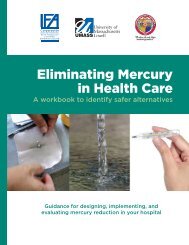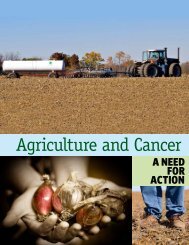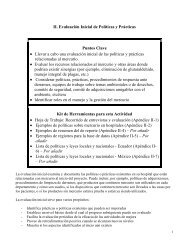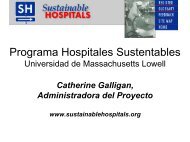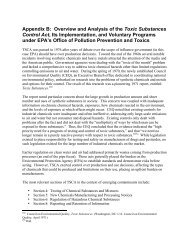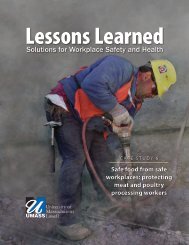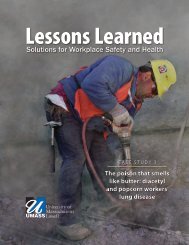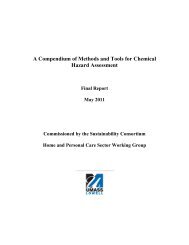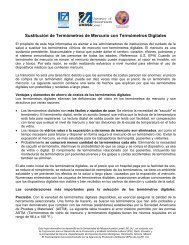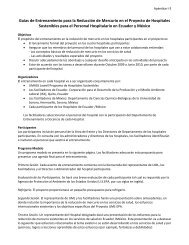Download - The Lowell Center Framework for Sustainable Products
Download - The Lowell Center Framework for Sustainable Products
Download - The Lowell Center Framework for Sustainable Products
Create successful ePaper yourself
Turn your PDF publications into a flip-book with our unique Google optimized e-Paper software.
<strong>The</strong> <strong>Lowell</strong> <strong>Center</strong> <strong>Framework</strong> <strong>for</strong> <strong>Sustainable</strong> <strong>Products</strong> | 9<br />
Understanding the Product Life Cycle<br />
FIGUrE 1 Typical Product Life Cycle (linear)<br />
Energy/<br />
Materials<br />
Energy/<br />
Materials<br />
Energy/<br />
Materials<br />
Energy/<br />
Materials<br />
Energy/<br />
Materials<br />
Product<br />
Design<br />
Raw Materials<br />
Extraction &<br />
Processing<br />
Product<br />
Manufacture<br />
Packaging/<br />
Distribution<br />
Product Use/<br />
Consumption<br />
End of Life/<br />
New Life<br />
Waste<br />
Waste<br />
Waste<br />
Waste<br />
Waste<br />
Adapted from ”IDEO-Sustainability: A Lens <strong>for</strong> Design”<br />
A<br />
first step in developing a framework <strong>for</strong> sustainable<br />
products is an understanding of the<br />
product lifecycle, because environmental and<br />
social impacts occur during production and<br />
disposal as well as use. <strong>The</strong> typical product life cycle looks<br />
something like the above.<br />
RECYCLE/REMaNUfaCtURE<br />
RE-USE<br />
it has been estimated that 70% of the life<br />
cycle cost of products is determined at<br />
the design stage.<br />
<strong>The</strong> life cycle <strong>for</strong> most products is primarily linear, beginning<br />
with the design process and including the stages of raw<br />
materials extraction, manufacturing, packaging/distribution,<br />
consumption/use, and ending with disposal in a landfill or<br />
incinerator. Re-use, recycling, and re-manufacturing are generally<br />
quite limited. At each stage there are material, energy,<br />
and labor inputs, and waste outputs. This “waste” can be in<br />
the <strong>for</strong>m of energy or materials but may also appear as occupational<br />
injuries or negative social and economic impacts<br />
on the local community, which are difficult to quantify. <strong>The</strong><br />
environmental and social impacts of a product throughout<br />
its life cycle are made up of these various <strong>for</strong>ms of waste.<br />
Decisions made at the design stage and throughout the<br />
product development and production process have ramifications<br />
<strong>for</strong> a product’s life cycle impacts. Extracting and processing<br />
raw materials may be hazardous to workers, degrade<br />
the environment, and harm local communities. <strong>The</strong> manufacturing<br />
stage poses additional occupational hazards, creates<br />
hazardous and solid waste, and causes air, water, and<br />
soil pollution. Packaging, distribution, and consumption/use<br />
of products often require significant amounts of energy and<br />
materials. At the end of a product’s useful life, its disposal or<br />
incineration may result in health and environmental impacts.



